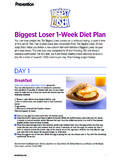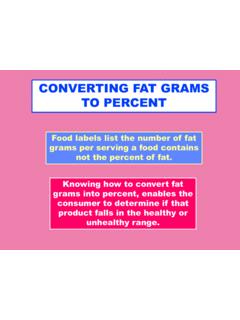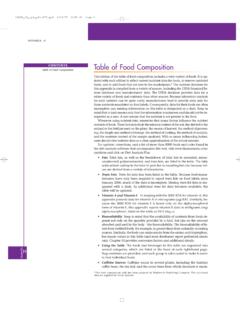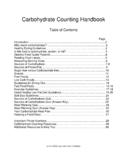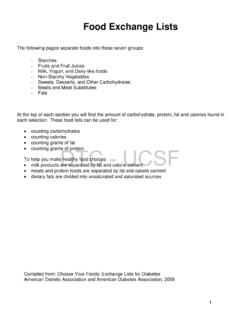Transcription of Meal Planning Guide 1200 Calorie - Cary Adult Medicine
1 Meal Planning Guide 1200 Calorie This Meal Planning Guide is based on the Exchange System, which groups foods into categories such as starches, fruits, vegetables, milk, meats and meat substitutes, and fats. One serving in a group is called an exchange. An exchange has about the same amount of carbohydrates, protein, fat, and calories as a serving of every other food in that same group. So, for example, you could swap one small apple for 3/4 cup of blueberries for one fruit serving. Sometimes nutrient figures may seem to vary a bit from list to list due to rounding-off, different serving sizes, or different methods of preparation.
2 But if you eat the specified number of servings of each group, you can be comfortable that you ll have a diet rich in nutrients and low in fat and calories . At first it appears a bit tedious measuring out an ounce of this and a cup of that, and with some foods it can be hard to measure or estimate an exact serving size. An inexpensive kitchen scale will come in handy. And these pictures will illustrate some helpful estimations: The palm, not including fingers and thumb, is about 3 ounces of meat. A fist is about 1 cup. The thumb is about 1 tablespoon. The thumb tip is about 1 teaspoon. Based on woman s hand size. Measure meats after skin, bone, and visible fat have been removed.
3 Do best you can, and hope little inaccuracies average out. Avoid snacks that are not counted in your meal plan, and avoid nibbling while preparing foods. These uncounted portions can add up to a significant number of calories , and are a frequent reason for people not to lose weight when they are otherwise following the meal Guide . For combination foods, like casseroles or dessert items, you may have to do a little research. For packaged foods, look at the nutritional label. For recipes you prepare at home, either add up the calories for all the ingredients and divide by the number of servings, perform an Internet search, or use a smartphone application. One particularly good resource is A diet that promotes weight loss is sometimes slightly deficient in some vitamins and minerals, so you should take a one-a-day type multivitamin/mineral/iron supplement.
4 An inexpensive generic will suffice. Initially many of these meals and servings will appear much smaller than you re accustomed to and that is, after all, part of the object here. To combat hunger as your appetite and serving-size perception adapt, it helps to drink a full glass of water at the start of each meal. Eat slowly; if you eat too fast, your sense of fullness doesn t get a chance to catch up with what you ve eaten. And make use of the free foods list items that you can add in addition to other foods listed in your meal plan. Exercise promotes weight loss and has numerous other health benefits; it is as close to a fountain of youth as you ll ever find. Start slowly and work your way up.
5 Even if all you do is walk the length of the yard, that s fine, as long as you go one step farther tomorrow. If your weight or arthritis problems prohibit you from walking for exercise, consider walking/exercising in a swimming pool; you ll burn a lot of calories without having to support all of your weight. Try to build up to 30 minutes of exercise daily. On the exchange lists you ll see several footnotes. Some of these tell you that that food selection counts as a serving from more than one group. And you ll see two other footnotes related to sodium (salt) and fiber: Foods marked with contain 480 mg or more of sodium per serving. The less sodium you get, the better. Foods marked with contain more than 3 grams of dietary fiber per serving.
6 The more fiber you get, the better. References: The Practical Guide : Identification, Evaluation, and Treatment of Overweight and Obesity in Adults; National Institutes of Health; National Heart, Lung, and Blood Institute; North American Association for the Study of Obesity; NIH Publication Number 00-4084; October 2000. NIH menu planner for 1200, 1400, 1600, 1800, 2000 cal diets. Daily Meal Planning Guide ; : Numerous online and smartphone weight management tools, including food and exercise Calorie listings. Choose Your Foods: Exchange Lists for Diabetes; American Diabetes Association and American Dietetic Association, 2007. 1200 Calorie MEAL PLAN Meal Sample Meal 1 Sample Meal 2 Breakfast 1 Starch 1 Fruit 1 Milk 1/2 cup bran flakes 4 oz banana 8 oz 1% milk 1 slice wheat toast 2 tsp no-sugar-added jam 3/4 cup blueberries 1 cup fat-free yogurt Lunch 1 Starch 1 Fruit 1 Vegetable 2 Meat 1 Fat 1 slice wheat bread 2 oz lean sliced ham Mustard as desired Lettuce as desired 1 slice tomato 1 Tbsp reduced-fat mayonnaise 1 cup raw carrots 1 apple 1 slice white bread 2 oz sliced turkey Mustard as desired Lettuce as desired 1 pickle 1 cup cherry tomatoes 2 Tbsp reduced-fat salad dressing 1 cup sliced cantaloupe Dinner 2 Starch 1 Fruit 2 Vegetable 2 Meat 2 Fat 1 small dinner roll 1 tsp margarine 1/3 cup rice
7 1/2 cup cooked broccoli 2 oz baked chicken Salad greens as desired 1 cup raw vegetables on salad 2 Tbsp reduced-fat salad dressing cup whole strawberries 1 small dinner roll 1 tsp margarine 1/2 cup corn 1 cup green beans 2 oz grilled or broiled flank steak 2 pecans, diced, on green beans 3/4 cup pineapple Snack 1 Starch 1 Milk 3 cups popcorn, low fat/no butter 1 packet sugar-free hot cocoa, mix & water 3/4 oz pretzels 8 oz 1% milk TOTAL DAILY SERVINGS 5 Starch; 3 Fruit; 2 Milk; 3 Vegetables; 4 Meat; 3 Fat. Notes: Include any amount of zero- Calorie beverages as desired, and selections from Free Foods list as suggested. If you prefer not to have a snack, roll those servings into your other meals .
8 You may also trade servings among the different meals , as long as the total servings from each group for the day remain the same. Take a multivitamin/mineral/iron supplement daily. FREE FOODS Each serving from this list has 5 grams or less of carbohydrate and less than 20 calories per serving. Eat up to 3 servings per day of the free foods with a serving size noted without counting the calories . Choices listed without a serving size noted can be eaten as much as you like. To help fight hunger and cravings spread servings of these foods throughout the day. Foods marked with contain 480 mg or more of sodium per serving. The less sodium you get, the better. SERVING CHOICES Low Carbohydrate Foods Serving Size Cabbage, raw 1/2 cup Gelatin, sugar-free gum Jam or jelly, light or no sugar added 2 tsp Salad greens Sandwich vegetables (tomato, onion, pickle, etc.)
9 1 slice Sugar substitutes (low Calorie sweeteners) Drinks/Mixes Serving Size Bouillon, broth, consomm Carbonated or mineral water, club soda Coffee or tea Diet soft drinks or sugar-free drink mixes Modified Fats/Dairy Serving Size Cream cheese, fat-free 1 Tbsp (1/2 oz) Creamers Nondairy, liquid 1 Tbsp Nondairy, powdered 2 tsp Salad dressing Fat-free or low-fat 1 Tbsp Fat-free Italian 2 Tbsp Sour cream, fat-free 2 Tbsp Yogurt, fat-free 2 Tbsp Condiments Serving Size Barbecue sauce 2 tsp Catsup (ketchup) 1 Tbsp Mustard Pickles, dill medium Salsa 1/4 cup Taco sauce 1 Tbsp Vinegar Seasons Serving Size Flavoring extracts Garlic Herbs, fresh or dried Nonstick cooking spray Spices Worcestershire sauceSTARCH Each serving from this list contains 15 grams carbohydrate, 0-3 grams protein, 0-1 gram fat, and 80 calories .
10 Many foods from this group also give you fiber, vitamins, and minerals. Prepare and eat starchy foods with as little added fat as possible. Choose whole grain starches as often as you can. In general, a single serving of starch is: 1/2 cup of cooked cereal, grain, or starchy vegetable. 1/3 cup of cooked rice or pasta. 1 oz of a bread product such as 1 slice of whole wheat bread. 3/4 to 1 oz of most snack foods (some snack foods may also have extra fat). Foods marked with should be counted as 1 starch + 1 fat serving. Foods marked with should be counted as 1 starch + 1 meat serving. Foods marked with contain more than 3 grams of dietary fiber per serving. The more fiber you get, the better.
